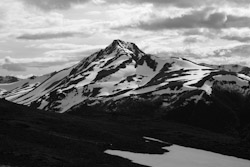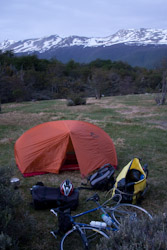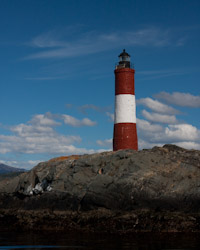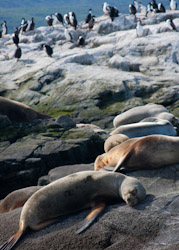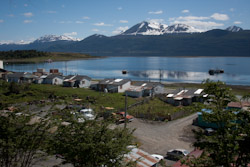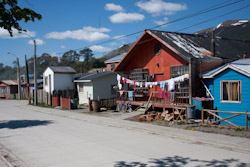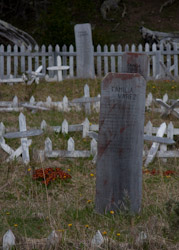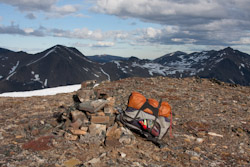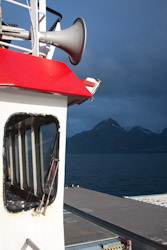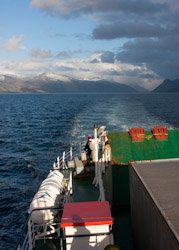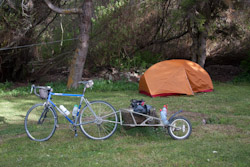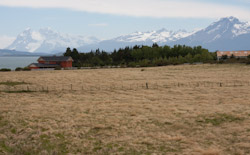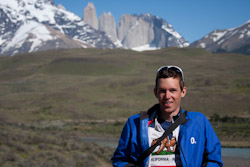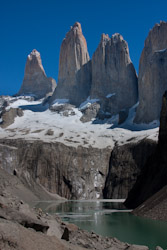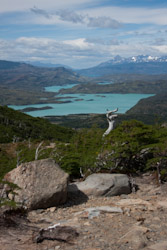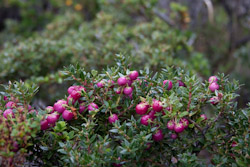
Introduction
For many, the word "Patagonia" conjures thoughts of true wilderness. Vast expanses of rugged, windswept land abutting frigid seas and daunting mountain peaks. A land where sheep outnumber people and roads are a few and far between. El fin del mundo (the end of the world) is as distant from Los Angeles as you can get in the Americas, both literally and figuratively. Over three incredible weeks I had the fortunate opportunity to explore the far Southern Hemisphere, witnessing the incredible beauty and gaining a better appreciation of how the “real Patagonia” compares to the romanticized image cultivated over the centuries.
Outbound Travel & Ushuaia, Argentina
Patagonia has long been a destination for the world's travelers. Men with names firmly planted in the annals of history such as Magellan and Darwin faced incredible barriers on their journey southward. Which brings us to un-romantic reality #1 of Patagonia: it is pretty easy to get there. Argentina's capital, Buenos Aires, is easily reachable from most US and European cities. A bit more than ten hours from Washington, DC by plane, the city of three million can be described as a mix between a gritty, pre-Giuliani New York and a historic European capital. Porteños (Buenos Aires locals) are known for their effusiveness, and this was readily apparent. As I was changing money in the airport, I overheard a teller speaking with a customer next to me. "It was just announced on the radio that our former president, Nestor Kirchner, is dead. I am so overcome with emotion." His face grew long as you could tell he was speaking from the heart. "I voted for him and loved him very much. It is such a sad day."
An easy change of airports was required to catch another flight three hours south to Ushuaia. One humorous observation on the flight to Ushuaia was the local news crew that boarded the flight just before departure. The cameraman held his camera sans case and placed it in the overhead bin. The rather homely-looking reporter held the microphone and cord coiled in her hand. A producer held a stack of crumpled papers. Seemed like a pretty ad hoc affair. The reporter sat next to me and noticed that I had a guidebook for Patagonia. She gestured to ask if she could read it, but returned the book after realizing it was in English. I assume that they were flying to Ushuaia only to continue on to the flight's next stop in the city of El Calafate, where former president had died earlier that day. Flying into Ushuaia is a dramatic affair. Surrounded by snow-capped mountains and known for fierce winds, landings into the world's most southern major airport are usually visually stunning and potentially a bit stomach churning.
One of the pleasing benefits of traveling by bicycle is being able to ride away from the airport under your own power. In about two hours I was able to reconstruct my Ritchey Breakaway and BOB trailer. However, one of the drawbacks of traveling by bicycle is increased complexity. I hoped that there would be a FedEx or some sort of delivery service such that I could send along my special bike bag to my final destination in Patagonia. Unfortunately there was nothing of the sort. I strapped the bag to my trailer, figuring that I could sort it all out later.
Marketed as el fin del mundo to traveler's around the world, Ushuaia is the core tourist hub for the most southern portions of Patagonia. An eternal boomtown, Ushuaia has little to hold the attention of travelers desiring to escape the beaten path. However, many creature comforts are available. Whether you need electronics, espresso, or a new Gore-tex jacket, there are plenty of shops ready to serve you on the main street of San Martin. Just be prepared to pay a premium. Attractions in and around the town include half-day boat tours, Tierra del Fuego National Park, Estancia Haberton, penguin colonies, the Martial glacier, and skiing in the winter. The town also serves as a popular point of embarkation for trips to Antarctica. Some travelers have been known to hang out in the city for weeks, patiently waiting to snag a cheap last-minute ticket. A 15 day trip that may go for $6,000 or more in advance can sometimes be had for under $2,000 for the lucky.
Riding through town, it was apparent that it was not just another normal day. The parks and squares were jam packed with kids and parents. Almost every single shop was closed. These people take their mourning seriously. The death of the former president was announced just hours before, and already everyone had left their jobs and closed their stores. Eventually I found one grocery store open and was able to stock up on food. I rode out of town and camped the first night in Tierra del Fuego national park, avoiding the steep $17 entry fee because no one was working at the entry gate.
The next morning I visited the park's impressive visitor center. The exhibits focus on the flora, fauna, and most interestingly the native yamana culture. These hardy people plied the frigid water and windswept terrain practically naked. No blankets, no furs. Fires were used for warmth even on boats, and on particularly cold days they might rub on a layer of seal fat. It sure makes you feel like a wimp as you read all this while inside a nice heated building wearing a beanie, long underwear, synthetic fleece, wool socks, etc., and still feeling a bit chilled.
I decided to splurge on my last full day in Ushuaia. I took a half-day boat ride through the Beagle Channel for about $40. It was a great way to see wildlife and take in the sights from a new perspective. I was taken aback by one sight, though. The vessel had the preppiest boat driver I have ever seen. What happened to the grungy, leather-skinned, chain-smoking, grunting, stained captain?
For dinner I visited one of Ushuaia's finer restaurants, Chez Manu. The restaurant has magnificent views of the city, channel, and surrounding mountains. Unshaved and clad in grungy bike clothes, I was the only customer in the entire establishment. A main course of lamb prepared two ways and a glass of wine set me back about $27. Not bad considering my lodging costs have totaled up to $0 for the first five days of the trip. After dinner I rode a bit farther uphill to my camping spot. It turned out to be a terrible site. I managed to pick a spot nestled in between lover's lane and racecar alley.
As a student pilot, I was dead set on finding a way to get some flight time at el fin del mundo. On my last morning in Ushuaia, I managed to sneak in a 30 minute flight above the Beagle Channel. What a perfect way to end the first leg of the trip.
Puerto Williams, Chile
Twenty-eight miles southeast of Ushuaia, Puerto WIlliams is a sleepy Chilean town mostly devoid of fin del mundo hype. The town is surprisingly hard to reach from nearby Ushuaia. One outrageously expensive tourist boat crosses the channel three times a week. It is also possible to charter an aircraft, but it would not be possible to bring my bike and gear. I even tried riding my bicycle to a small port town merely four miles from Puerto Williams, hoping to pay a fishermen to take me across. No luck. They said it was not possible because of the immigration restrictions. I resorted to the 50 minute boat ride across the channel, setting me back $120 in the process. The boat whisked me and 8 other tourists across the glassy channel at 30+ knots (35+ mph, pretty darn fast for those who don’t think in nautical terms.) As it turns out, one passenger, an older gentleman, was an MIT alum in civil engineering. The Santiago, Chile, native had just taken a cruise with his wife and friends through the channels and around Cape Horn, the true tip of South America. Sounded pretty nice!
Despite the drop-dead gorgeous setting, Puerto Williams itself is not the prettiest town. “Downtown” consists of four blocks of paved streets, three grocery stories, one restaurant, and a handful of other stores and hostels than always seem closed. The homes are almost all identical, pre-fabricated white structures evenly spaced along the dirt streets. Roughly one-third of the 2,000 residents are part of the Chilean armada (navy). Most move there for financial reasons, sailors make about twice as much money when assigned to the remote town. As I hung out in the deserted main square, several tourists vans drove by, some full with their entire family on board, and eagerly asked if I needed a hostel for the night. They lost interest in me as soon as I mentioned I was camping. I think that in the early season innkeepers outnumber tourists on the island. Next I headed down to the yacht club for lunch. I had read in my guidebook about a grounded military vessel that has since been turned into a restaurant. Sounded pretty cool. I arrived only to find it closed and “under construction,” a loosely used term given the lack of materials, people, or any sight of rehabilitation in process. Wandering back into town, I eyed the outside of the large museum (also closed) and large boardwalk filled with benches overlooking the water (with not a person in sight). All in all, this place feels a bit like a tourist ghost town.
There is only one road on the island outside of town. It runs east about 20 miles from town and west about 35 miles. I have 6 days to explore the environs, so I decided to start out heading east. The road is dirt and pretty hard. Winding along the rugged coast, there are few flat stretches. At times it is even necessary to push the bike up the steep, gravely roads. Dramatic views across the Beagle Channel are occasionally interrupted by various blights: abandoned fish processing factories, broken down cars, trash washed up by the waves, and even illegal dump sites.
Eventually I reached the “end of the road at the end of the world.” The most southern part of my trip, it was a serene place to relax and take in the views and reflect on the journey thus far. I decided to find a camping spot hidden from the road and call it my home for the next two days. It was great to have a real rest day, with no riding, airplane rides, bus trips, or requirements of any sort. I did a bit of walking around and read Yvon Chouinard’s Let my people go surfing,
an autobiography by the founder of the Patagonia clothing company. Focused on environmentalism, business, and enjoying life, it was the perfect book for the occasion. I found the book inspiring, and would recommend it to most anyone to read. However, it nagged on me a bit knowing that Patagonia’s financial success is not so tied to the egalitarian spirit of the company as the book might lead you to believe. Much of the success is driven by the consumer desires to buy into a lifestyle. The technical, pricey clothing offered by the likes of North Face and Patagonia often encourages overspending and places immense value on the label and look. Yes, the intended user may be “hardcore”, but average actual buyers do not need (and probably cannot afford) such items.For my next destination, it was necessary to ditch the bike for a day. I decided to hike into the mountains south of town for a night in the backcountry. I packed my small backpack with enough gear to survive the night comfortably and stashed my bike in the woods. The trail ascends 3,000+ vertical feet until well above tree line. Snow fields still lingered alongside the jagged ridgeline and vast talus fields. The moderate weather down below was quickly replaced by near-freezing temperatures and stiff wind gusts. I located a somewhat protected area to pitch my tent and started to make camp for the night. However, the winds seemed to strengthen by the minute. By the time my tent was assembled, it was practically flattened to the ground by the steady blowing. With a snow-packed cornice and precipitous cliff just downwind of me, this was not place to be blown away in the middle of the night. Even though the sun was about to set, I opted to break camp and speedily hike another hour or more until back in the trees. Isla Navarino is a nice place and all, but I had no interest in having it be my final resting place.
The following morning I awoke to an uninflated mattress pad. Damn. I must have brushed up against something sharp during my hike and punctured the pad. Not the end of the world, but definitely makes sleeping in the tent a little less comfortable.
Riding west from Puerto Williams, my next destination was the tiny hamlet of Puerto Navarino. After a few easy miles, the road turned difficult once again. Rarely flat, the road climbed and descended along the jagged coastline. My legs burned with pain on the brutally steep uphill stretches. Casual coasting on the downhill was impossible. The steep grade and rutted road required constant braking and total mental focus to avoid flat tires and damaged wheels.
The 35 miles took nearly four hours. I arrived a bit before sunset, just as the rain started to fall. A group of armada guys were barbequing nearby. I asked them if there was a good place to setup a tent nearby. They graciously allowed me to sleep inside one of the abandoned houses. Puerto Navarino consists of about 4 houses, and only one is occupied. They asked if I would join them for dinner, and of course I accepted. On the grill was an abundance of centolla (king crab) and locally-raised beef. Jote was the drink of choice, a mix of red wine and Coca Cola. Mixing wine with anything certainly offended my California sensibilities, but it was actually pretty good. A 2 liter box of wine can be had for about $4.00, so it is popular drink for people of all ages and economic levels. The friendly sailors quickly adopted me as part of the group. Between their limited English and my broken Spanish we managed to chat communicate pretty well. As the night wore on we went down to the dock and boarded a small fishing ship that had supplied the centolla for our dinner. It was an eye opening sight to see the crew and captains’s tiny sleeping quarters. The captain invited me into the wheel house / sleeping quarters to take a picture. Next thing I knew, I was being invited onto the boat for a day of fishing. He explained in simple Spanish for me, “You. Here. 6am in the morning. We fish for centolla.” “Yes, perfect.” I replied with enthusiasm and a bit of shock.Crab Fishing
It was a clear, cool morning on the Beagle Channel. I should have slept better considering the presence of a matress and a solid roof over my head, but I was eagerly anticipating the day of fishing ahead. My day on the Yolanda started at 6:30am with a simple breakfast. The fishermen begin the day with cigarettes, bread, butter, mortadella, cigarettes, mate (tea leaves soaked in hot water and sipped from a dried gourd), cigarettes, and instant coffee. Did I mention cigarettes? The four of us huddled in the small rear cabin that also serves as sleeping quarters for the two crew members. The small table sits directly atop the ancient diesel engine. A two-burner gas stove runs all day to maintain a supply of hot water and keep the tiny room warm. After scarfing down some chow, the crew put on their layers and headed outside. The still, quiet morning was concluded abruptly as the diesel motor coughed to life and spewed noise, fumes, and fuel into the picturesque environment.The crew didn’t speak a word of English and my Spanish can only be considered poor at best. We started out with the most basic dialogue (what is your name, where are you from, how many days are you here, etc.), but we steadily communicated more and more through the day with the help of my Spanish-English dictionary and a regular flow of beer and wine.
While preparing the boat for the day’s work, one crew member began to move a pile of large white bags from the bow of the boat. To my surprise, I noticed what looked like a seal at the bottom of the pile. I asked quizically about the large sea animal as the crew uncovered the entirety of dead mammal. Intrigued, I asked the captain a few questions. “How long has it been dead?” “One day. I shot yesterday.” “Where?” “A ways off to the west is an island with lots of seals.” Oh, so they actually had to go way out of their way to shoot the poor guy. “What is it used for?” “For the centolla traps and other things.” “Other things?” A crew member brought over a huge kitchen pot and lifted the lid to reveal gallons of seal fat. “We use this for our cooking.” Well, how nice. As I began to look around the boat, I realized that the chunks of flesh that I thought was beef or fish guts scattered about the boat in various stages of decay was in fact seal. At least they are making the most of the animals they kill.
We spent the morning hopping from spot to spot, pulling up long “line nets” designed to lay on the sea floor and entangle the centolla. Each net holds a few crab, and the first two that are not legally large enough to sell are thrown in a pot and cooked up immediately. If you think that “right off the boat” means that the seafood is fresh, well “right on the boat” is even fresher! After laboring on the line nets for a few hours, the crew transitions over to spots where they have placed round metal traps. The traps seem to catch more crab, but many of these are undersized. To my confusion, they keep pretty much all of them regardless of their size.During a break in the action, the captain turned to me and said with a straight face, “Can you take a picture of me and post it in America so that I can find a wife?” “Uh, sure.” I figured he was only joking, but he remained solemn as I had him pose for a few headshots. Meanwhile, the crew members laughed uncontrollably. Unphased, the captain went on to describe his ideal mate. “I want a very skinny woman. Very, very big breasts and a round butt. But very skinny.” Sounds like someone has been watching too much Baywatch in the off season. I nodded with understanding as he continued to emphasize the desired physical features in great detail. His daydreaming was only eventually interrupted by the need keep the boat headed back to port.On the way back into the sheltered cove where we started the day, we stop by a shallow spot and pull up several traps jam packed with huge crab. The crew stores their previous catches here until they are ready to sell their load. We then docked alongside a larger boat that serves as the first in a series of middlemen that participate in the crab business. The legal size crab are sold for cash, while the undersize crab are “traded” for beer, wine, and cigarettes.
By the end of the day the captain had me at the helm, navigating the lumbering Yolanda, through narrow passages between islands as he supplied my with all the wine I could handle. As we headed back to the pier, the captain made sure I remembered what he was looking for in a woman. After securing the vessel, we shared hugs, US dollar bills, and mailing addresses. I gave them my email address, but it was received with blank stares. I tried to hide my grin, as one of them finally suggested “I think my nephew has email.” Their world, devoid of Gmail, Facebook, Twitter, and whatever other services of questionable value, is increasingly rare in this age.
It was an unforgettable day and a good reminder that often the best experiences are the ones that you cannot plan.
Upon finishing my day on the crab boat, I returned to Puerto Williams and decided that it was time to finally give up the tent for a night and find a hostel. After nine days cycling, hiking, and now fishing, it was time for a proper shower and a real bed. It was also nice to be in relative civilization again in tiny Puerto Williams. Surprisingly, the town was abuzz with activity upon my return. The townspeople are notoriously uninvolved, so a number of activities were planned for the day to raise funds as part of a national fundraising campaign. I attended a concert consisting of local folksingers, clowns, and rappers. The headliner was flown in from Santiago, a wannabe heartthrob who placed third on Latin American Idol. I could not help but laugh as the little girls shrieked with pleasure at his kitsch dance moves and overly dramatic songs. I missed out on the late-night event reserved for the men of Puerto Williams. As part of the fundraiser, two exotic dancers were flown in for the evening to provide adult entertainment at a local bar. “Strippers for the children,” what a novel idea!
Ferry
The Bahia Azul (blue bay) sails weekly between tiny Puerto Williams and Punta Arenas, a city of 120,000 known as Chilean Patagonia’s transport hub. The two-day journey is shared with about 15 other tourists and a few containers of frozen centolla. The industrial-looking ferry chugs through the Beagle Channel, passing snow-capped mountains and crystal-blue glaciers along the way. We even made a few stops at tiny outposts used by the carabineros (police) and armada (navy). In some cases these outposts were a single house, where a family lives in near isolation for two years at a time. We actually had two carabineros, on board the ferry that were about to start a two month stint at one of the outposts. We had a chance to chat over a meal just before they were dropped off. Interestingly, Chile has only one police organization for the entire country. A carabinero in the north protecting a national park is in the same police force as someone working in Puerto Williams. It is also a fairly common for them to move to different parts of the country for assignments. I explained the polar opposite nature of the American system. We have federal police, police for many departments of the executive branch, state police, county police, city police, beach police, park police, wildlife police, transit police, and probably many more that I have forgotten. Our system helps represent local interests, but sometimes at the expense of bloated administration and petty squabbles over jurisdiction.
Food is in abundance on the boat, and a jovial atmosphere dominates among the tourists on board. I spend much of the first day outside admiring the sights. The weather was generally clear until mid-afternoon when we all noticed a wall of darkness ahead of us. “Oh well,” we lamented. “At least we had good weather for part of the day.” From the looks of the looming storm ahead, we were in for some bad weather for the rest of the day. Within minutes the temperature plummeted, the winds grew more unpredictable, and the snowflakes began to fall. It was incredible how quickly we went from blue skies to near-whiteout conditions. Unsure how long the fury would last, many tourists headed indoors while other sought protected areas above deck. Even before the novelty of the storm could wear off, we noticed a hint of light on the horizon. Within ten minutes the snow stopped and the clouds started to break. Soon the sun was shining again and we could not help but laugh at our comments about the impending doomsday that we were lamenting just 45 minutes earlier.
This incredible cycle repeated itself time and time again over the next twelve hours. None of us, all fairly seasoned travelers, had experienced such dramatic and rapid weather changes before. As day turned to night and we weathered our seventh or eighth storm, the tourists starting celebrating at the end of each storm. Feliz Ano Nuevo! Happy New Year! The seasons were passing by at rapid pace. We expected it to be the year 2025 by the time we made it to Punta Arenas.
Day 2 on the ferry was less eventful. As we entered the Magellan Strait, the seas became much more rough and the flat-bottomed boat rocked heavily. Just as my stomach began to settle down after a long bout of large waves, I headed to the galley for my final meal. I was looking forward to the grand finale dish of the trip, but my hopes were dashed when the steward came out with a heaping plate of tripe (sheep’s stomach). The steward hovered over me to see my response. On the inside I cursed while blurting out a cheerful, “Wow, this looks really good.” The French tourist next to me had similar feelings that we discussed secretly in English while the steward continued to watch us. We had no choice but to force down the entire plate of rubbery chunks that I would not even want to serve my dog (if I had a dog). “Mmm, really good.” “Do you want some more?” “Uh, no thanks. I’m pretty full,” I almost laughed outloud at the hilarity of being offered more of this tasteless pile of slimy, chewy innards. The French lady and I shared a high five upon completing our challenge at the dinner table. Nothing like a stomach full of stomach.
Bike Ride to Puerto Natales
Rolling off the ferry at dusk, I knew that I didn’t have much time to get out of town and find a good camping spot. Chileans take property rights seriously, and most land on either side of the road was fully fenced. Eventually I noticed a spot along the coast that was accessible via an overgrown dirt track. It turned out to be a great little place to camp for the night, sitting atop a bluff overlooking the water. Not bad for the price of FREE, and sure beats the hassle of riding into the city, finding a cheap-but-usually-disappointing hostel, and then riding out of the city again in the morning.
Surprisingly, I woke up early to calm air. The ferocious wind that I was so expecting was absent. Riding along the paved roads with no wind was a luxury that I hadn’t felt in many days. Cruising along at 12 mph, a speed easily reached on any bike under civilized conditions (paved roads, no gear, no wind, etc.), felt downright blazing. The first ten miles passed quickly, and I started to think that I might avoid the dismal conditions that I had read about on this stretch of road.
Wrong. So very wrong. Over the next few miles, the wind began to build. Within a few short miles my cruising speed was cut in half. Each mile became a challenge as I struggled to keep the bike moving forward. When the wind blew from the side, even just a bit, it became difficult to keep the bike pointed straight. Getting blown off the road became a regular occurrence. Passing buses and trucks added to the danger. Passing by, they would block the wind and thereby suck me into the roadway. As they departed, the winds would instantly return and blow me back into the soft shoulder. The dual requirements, intense physical exertion and absolute mental focus, were constantly at odds with each other.
Each fifteen miles I would take a break, and not your normal five minute breather. These breaks consisted of getting off the bike, finding a spot somewhat protected from the wind, eating whatever food I had handy, drinking water, and even taking a nap. About 50 miles into the ride, I saw a fully-loaded cyclist heading in the other direction. “In three miles you will have a tail wind.” It was music to my ears. After navigating past a flock of sheep, I stopped for lunch at a roadside restaurant. The waitress described the two specials of the day and was a bit surprised when I ordered both. The only other person in the restaurant was a French tourist. As further proof of how small the world can be, he happened to be an alum of UCLA (where my wife is currently a student). Soon enough it was time to mount the bike again and seek out this supposed tailwind.
Sure enough, with the combination of a bend in the road and large hills funneling the wind just the right way, for the next 30 miles I enjoyed an awesome tailwind. Cruising at 15+ mph while barely pedaling felt magnificent, a sensation more like riding on a silent motorbike than a bicycle. My entire mental state changed as the soundtrack in my head shifted from “Highway to Hell” to “Magic Carpet Ride.” The grass seemed greener, the scenery more stunning, and the air more fresh. I knew that these pleasant conditions would not last all day, so I tried to enjoy it while I could. 80 miles into the ride, the road made a big left-hand turn and the predominant tailwinds became a nasty head and/or cross wind once again. Running on fumes, I stumbled off the bike at Hotel Rubens, 104 miles after beginning the day. For $7.00 I was able to setup my tent in a nice protected spot and enjoy a luxurious hot shower. The restaurant on site served up a heaping plate of steak, fried eggs, grilled onion, french fries, and fresh bread. After chowing down in record time, I headed back to the tent, ate a huge bar of chocolate weighing nearly half a pound, and still went to bed feeling a bit hungry. I nodded off somewhat reassured, knowing that tomorrow’s ride would be less than half as long.
I woke up early to a body that felt many decades older than my 26 years. Ignoring all the sore muscles and aching joints, I hit the road at 7:30am hoping that the early morning hours would offer respite from the wind. The ~45 miles to Puerto Natales did not come easy. The rolling terrain, unrelenting winds, and tired legs meant that every mile had to be earned. I continued with my breaks every 15 miles, but had to increase the frequency as bit as my body started to weaken under the constant strain. A bit after mid-day I reached Puerto Natales, a growing town that serves as the gateway to Torres del Pain national park. With plenty of gear shops, travel agencies, and touristy restaurants, Puerto Natales still manages to maintain a pleasant local vibe. I spent the entire afternoon in a coffee shop catching up with email and enjoying the incredible luxury of being indoors.
I was not planning on spending much time in Torres del Paine national park because I had read in a guidebook somewhere that hiking solo was not allowed. A friendly tourist agent informed me that this was not the case, and the next thing I knew I was prepping for a five day backcountry hike. Needless to say, I was not quite equipped for backpacking. I only had cycling shoes to wear on my feet and did not have many warm layers to protect against the unpredictability of mountain weather. However, with a small 30 liter backpack and plenty of camping gear, I knew this was an opportunity not to pass up.
Torres del Paine, Chile
World-renowned for its backpacking trails and climbing routes, Torres del Paine national park is one of Patagonia’s gems. The park attracts tourists of all ages and ability levels, from professional big wall climbers to out-of-shape day trippers. Sitting in the middle of that spectrum, I planned to hike the popular “W Circuit” over the course of five days.
The park is easily reached by bus from Puerto Natales in about two hours. I arrived at the park entrance on a postcard perfect day. After paying a steep entrance fee of $30, I hopped in a 15 passenger van for a final ride to the start of the trail. The van sped across the winding dirt roads, blasting techno music as the driver navigated at break-neck speeds. We crossed an impossibly narrow bridge, ignoring the signs to unload passengers before crossing. With less than 2 inches of clearance on either side of the van, the driver stuck his head out the window and drove with incredible precision.
It was the best day of weather so far, and I continually stripped off layers as I began the first leg of the hike. Day 1 consisted of a hike up to the famous Torres del Paine. The three grandiose towers were originally columns of molten rock slowly making their way to the surface. Before breaking through the surface, the columns cooled into solid granite. Over millions of years the surrounding soil eroded away, leaving the giant pillars exposed.
The final stretch to the viewpoint of the towers becomes quite steep. There were long lines of folks slowly huffing and puffing their way up the mountainside. Some folks looked more suited to a nursing home than the rough trail. I joined up with a French-Canadian firefighter, Frederick, who was also hiking along at a good pace. We hurried past the long lines of folks taking breaks and looking quite tired. Frederick commented to one older lady, “Good on ya. You would never catch my mum on such a trail.” Without skipping a beat, the lady replied in her out-of-breath English accent, “Well given the state of things, I would have to say that your mum is quite a sensible person.” We reached the top greeted by impeccable weather and even took a quick dip in the iceberg-laden lake. Later in the day, I decided to continue on past the standard “W” route and headed toward the Valle de Silencio (Valley of Silence). It was a nice change going from a trail absolutely full with inexperienced tourists to complete solitude, not seeing anyone for the entire 3 hour trip.
Day 2 was a long day, hiking back down to the main trail and then up to the middle point of the “W”. I spent most of the day chatting with a German couple who had spent the previous 2 years sailing the world by boat. We met on the ferry from Puerto Williams and reconnected randomly on the trail. Most people leave their pack at the bottom of the middle leg and hike up and back without a pack. I decided to hike with my gear and camp at the distant Britannica camp. My feet were really starting to take a beating, but I knew that the far campsite would be quieter than the busy site near the main trail. Only three tents used the campsite for the night. Several times I awoke to what I thought was thunder, but in reality it was the sound of nearby glaciers calving, sending enormous chunks of snow and ice down the steep mountain faces. The faint pitter-patter of hail on the tent reminded me of the dropping temperatures outside. I nervously hoped that weather would pass before morning.
After ~16 miles on the second day, Day 3 turned out to be even longer. The morning greeted me with a thin layer of hail coating the ground. The wind was a bit stronger today. I climbed a bit further into the valley to take in the views and then descended back to the main trail.
Finally it was time to visit the final leg of the “W.” The winds grew stronger and fiercer as I approached Lago Grey. At one exposed viewpoint, I practically had to crawl on my hands and knees to avoid getting blown over. The elongated lake is peppered with icebergs that are deposited from Glacier Grey and slowly blown across the lake. The massive glacier, nearly 3 miles wide at its base and over 17 miles long, is a stunning sight. I charged on to my camping site for the night a Lago Grey Guardias, ~19 miles total for the day. Tired, hungry, and cold, it was time to make dinner and let my jello-like legs get some rest.Day 4 was a much-needed rest day. After sleeping in until a luxurious hour, I hiked further along the trail to take in additional amazing views of the glacier. The trail has some awesome stretches, even diving down into a snow-packed slot canyon at times. Most hikers agree that this is the most stunning strech of trail in the national park. In the evening I had a chance to reconnect with the international teachers that I had met at the very beginning of the hike. Pretty much the whole campsite of folks (5 tents or so) hung out at the campsite’s viewpoint taking in the glacier’s magical glow in the soft evening sun.
Day 5 consisted of a quick ~3 hour hike back to main trail. While waiting for the catamaran to shuttle me back to the bus pickup point, I finished off the last of my food. I definitely had enough grub to survive just fine over the few days, but I could tell that my body had been running on a pretty major calorie deficit. The rest day felt nice, but my legs still felt severely fatigued. Between the hiking and riding, my legs were pretty much shot. It was time to take it easy for the remaining few days of the trip. Back in Puerto Natales, my first visit was to the shower and my second trip was to the grocery store. I bought all sorts of empanadas, bread, pastries, snacks, chocolate milk, etc. My body was happy to accept all the calories I could shove down my throat. Then I hobbled to a nice restaurant and had a huge plate of Patagonian lamb. Dessert consisted of a few more pastries and another half-pound chocolate bar. Yeah, I was that hungry.
BA, Colonia, and Travel Home
After three weeks wandering through small towns, mountain ranges, and patagonian steppe, the prospect of traveling to a busy metropolis had little appeal. Arriving into the international airport late in the day, I sought a place to store my large checked bags until I need to return the following night. Unfortunately there were no left luggage facilities to be found in the airport, but I was able to keep my bags at the central bus station for Manuel Tienda Leon for a very reasonable $2.50. With only a small backpack, I was free to roam Buenos Aires (“BA”) by foot unencumbered. The walking street of Florida in the microcentro district is jam packed with street vendors plying wares of varying interest. Plastic doo-dads and cheap clothes dominate the space, interspersed occasionally by handicrafts and artwork. The stark consumerism was like a slap in the face after spending night after night in a tent and buying little more than food for sustenance. After covering a few miles of ground, I settled down for a late dinner at a bar advertising food specials and free wifi. Given my lacking enthusiasm to explore BA for a full day I decided to purchase a roundtrip ferry ticket to Colonia, Uruguay.
Colonia is reachable in 3 hours by normal ferry from BA and a mere 1 hour by fast ferry. Within a minute’s walk of the modern yet characterless ferry terminal, you are suddenly introduced to the charming neighborhoods of old town Colonia. With cobblestone streets, crumbling plaster walls, mature trees, and antiquated cars, the historic quarter’s tranquilo vibe is sure to soothe even veteran cynics. Granted, tourism’s impact is noticeable. Rental golf carts, waterfront restaurants, and trinket stores are designed for the day trippers but only slightly subtract from the town’s magical feel. I spent the afternoon with a grin on my face as I explored the quiet streets on foot. My lunch, an ultimo sandwich from a street vendor, consisted of a hamburger topped with ham, bacon, chicken, prosciutto, cheese, peppers, and lettuce. This thing even put America fast-food to shame. I washed down the $3.50 monstrosity with a local beer, and thanked the cook for his calorie-laden creation. Before I knew it I was heading back to the ferry. The short ride back to BA traverses the Rio de la Plata and brought me back to the 21st century.
After a bit of time walking through BA, it was time to head to the airport and take a red-eye flight to Washington, DC. After passing through security at BA’s international airport, all passengers are forced to walk right through a seemingly unending duty free shop before arriving at their gate. The unabashed consumerism was overwhelming. After weeks largely removed from the glam marketing so unavoidable in normal life, I could not help but be completely uninterested in it all. I had about $50 left in Argentine Pesos but could not even bring myself to spend it.
I managed to avoid a scheduled 9 hour layover in DC and caught the first available flight to Los Angeles. The flights were pleasantly uneventful; I only hope that my seatmates were not too bothered by my haggard look and less-than-fresh odor.Closing Thoughts
Three weeks in Patagonia. In many ways it felt much longer. Usually this expression is used in a negative context, but for me it was fantastic way to fit in a (what felt like) three-month journey into three weeks. Maybe it was the camping, the busted sleeping pad, the bike rides over rough roads and against strong winds, the long hikes in cycling shoes, the days of solitary travel, or the mentally-taxiing language barrier. Well, whatever it was, I enjoyed every minute of it!
Copyright © 2010-2011 by Kieran Culligan. All rights reserved.
